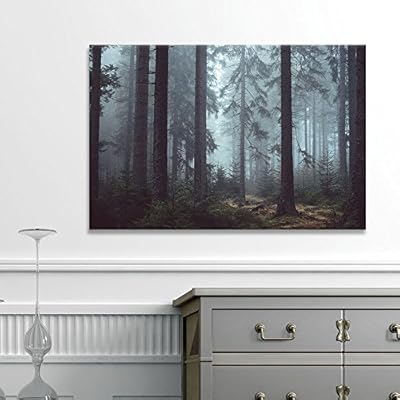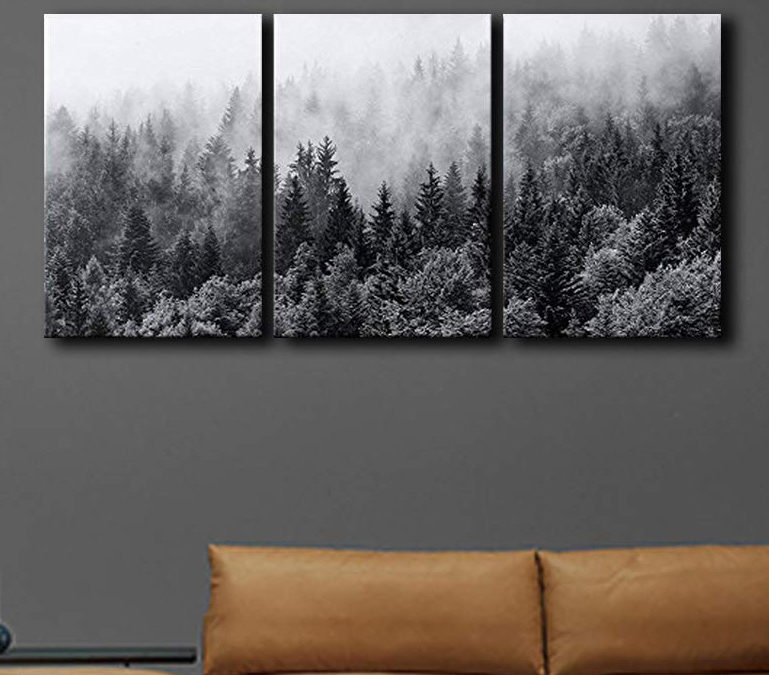There are so many beautiful, scenic environments on Earth. Have you ever simply enjoyed yourself by sitting on a park bench, and taking in the midday sun? Have you ever lost yourself in an extremely windy environment? Ever sat down and gazed at a lightning storm from the comfort of your own home? Wonderful weather moments like these are what make life so exciting! There is one interesting weather phenomena we haven’t discussed yet; fog! Fog and mist are some of the most interesting phenomena. Simultaneously mysterious, beautiful and dangerous, fog and mist are extremely interesting! Do you want to know more about them? Read below for some great fog & mist wall art facts!
Through Thick & Thin

- So, what exactly is fog? Fog is a type of cloud that has lowered enough to touch the ground. Fog can be thin or thick, and we’re sure you’ve experienced both! Fog can be so thick, that it completely obscures passing cars or even landmarks like the Golden Gate Bridge in San Francisco. Fog occurs when water vapor, water when it has been vaporized into gas, condenses. During this condensation process, molecules of water vapor combine to form liquid water droplets that hang still in the air. The reason you’re able to “see” fog and mist despite them technically being whit and invisible is because of these droplets!
- Although it usually occurs when it’s cold, the environmental conditions to create fog have to promote humidity for a short time. Fog only happens when enough humidity has gathered in a particular location. In addition to that requirement, fog can only form when dust or some other type of particular matter is in the air. Water droplets need something to hang on to in order to stay still and static. Depending on the humidity and the availability of particulate matter, fog can both form and disappear quickly. Instances like this are called flash fog.
- Although they are very similar, with their conditions for existence being the same, fog and mist are technically not the same thing! Fog is denser than mist is. In other words, fog is thicker and can obscure more than mist can. With fog there are more water molecules, and thus more particulate matter for them to hang onto. Fog cuts visibility down to over half a mile, while mist cuts visibility down considerably less.
- There are several different types of fog. One kind is called radiation fog. This type of fog forms during the evening when heat absorbed the the surface of the Earth is radiated into the air. As this heat is transferred from the ground to the air, water droplets are created. This type of fog sticks very close to the ground due to the humidity being so close to the Earth’s surface. This fog usually forms at night, and disappears with the morning sun. Read below for more fog & mist wall art facts.
The Fog Always Lifts

- Another type is called advection fog. Advection fog forms when wet, warm air passes over the surface of something cool. When moist and warm air makes contact with cool surface air, the water attached to particulate matter within this fog is condensed to create fog. Advection fog show up most commonly where warm, tropical air meets cool ocean water. Familiar with the Pacific coast of the United States? The area from Washington to California? This area of land is usually covered with advection fog.
- Interested in learning about more types of fog? There’s also valley fog. This fog forms in mountain valleys, most commonly during the winter season. Valley fog develops when mountains prevent the dense air around them from escaping. The fog is thus trapped within the crevice of the valley. Another type of fog is called freezing fog. This type of fog occurs when liquid fog droplets freeze onto solid surfaces. For instance, mountain peaks that are covered by clouds are usually covered in freezing fog. When freezing fog lifts, anything that it covered – be it trees, logs or rocks – is covered by a layer of frost.
- Did you know that fog has actually been utilized as a form of water collection. Many ancient cultures collected water from fog by placing big pots under trees or other forest plants. This method of collecting water was not as effectives as gathering rainwater, but it still served its purpose well enough.
- To continue with the idea of “fog catchers,” did you know that people that collect fog still exist? Today, they’re mostly engineers. In today’s world, it’s important to be as eco-friendly as possible. To that end, engineers work on sophisticated methods to collect water from fog. Today, they utilize thin large, thin screen and place them in arid areas. As fog drifts through the screens, water droplets are caught and eventually drip into collection pods below. In one day, a single screen can amass more than a hundred gallons of water! Crazy, right! Did you enjoy these fog & mist wall art facts?
Conclusion
Now that you know more about fog & mist, what do you think? Are you amazed by the fact that there are several different types of fog? Are you shocked that fog and mist are actually quite different from one another. Maybe you’ve grown to appreciate fog and mist, and feel humbled to know how dangerous they are? Whatever you think, we hope you learned something today! We hope you enjoyed reading these fog & mist wall art facts!


